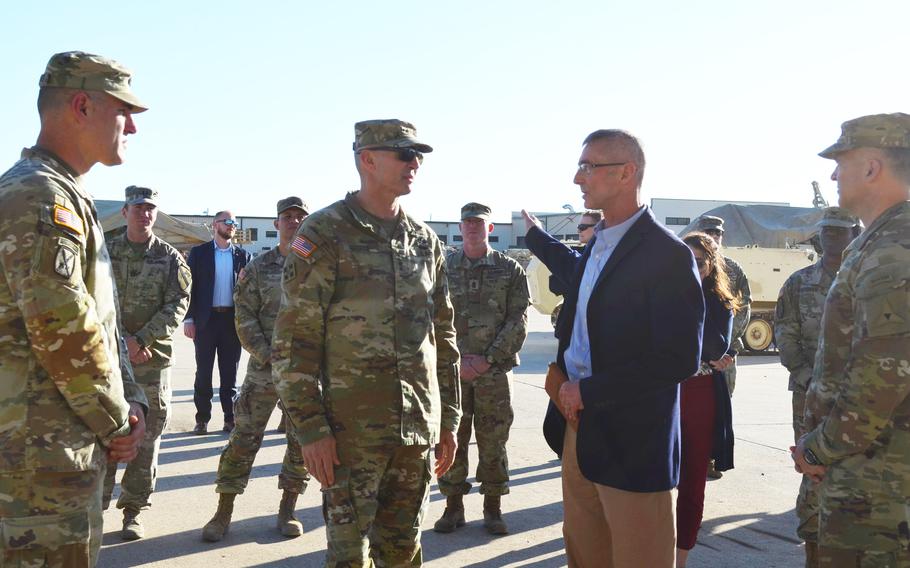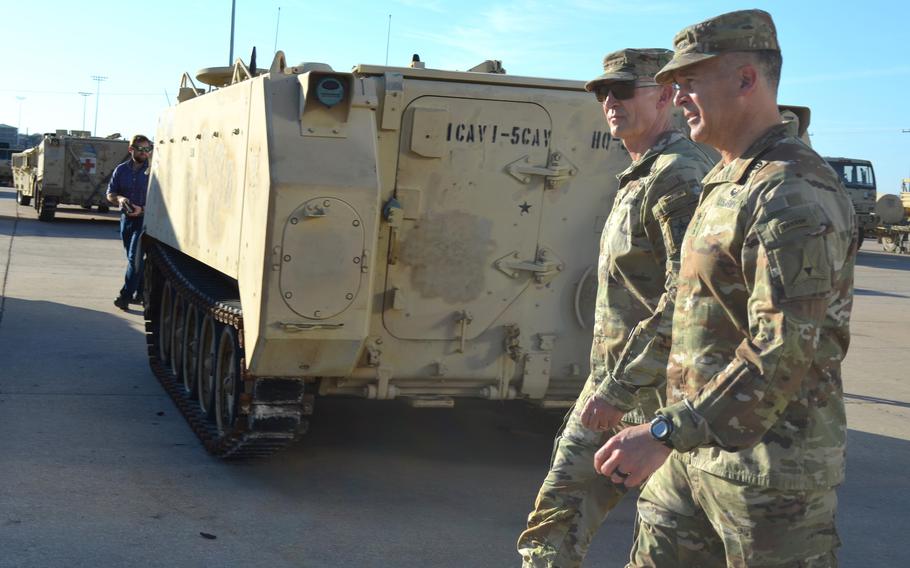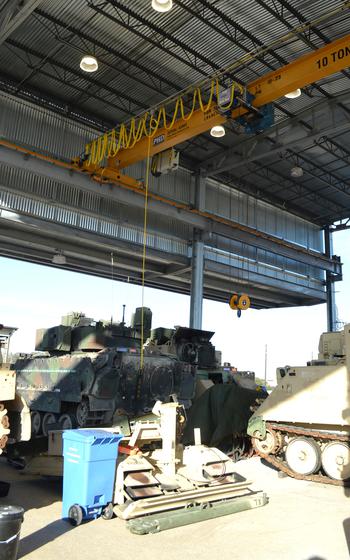
Gen. Randy George, the Army chief of staff, center left, on Tuesday, Feb. 20, 2024, listens to Brian Dosa, director of Public Works at Fort Cavazos, discuss motor pool facilities at the Texas post. (Rose L. Thayer/Stars and Stripes)
FORT CAVAZOS, Texas — The Army’s recruiting numbers are stronger than they were at this time last year, the Army’s top general said Tuesday while touring a motor pool and visiting with soldiers at the base.
“Last year we improved by 10,000. Right now, we’re above that glide path,” said Gen. Randy George, the Army chief of staff.
George’s tour followed Army Secretary Christine Wormuth’s visit about three weeks ago at Fort Cavazos, where both service leaders saw units working within the ripple effects of the Army’s failure to recruit enough soldiers during the past two years.
In fiscal 2023, which ended Sept. 30, the Army enlisted about 55,000 recruits. While short about 10,000 of its goal, it was about 10,000 more than the previous fiscal year, according to information previously released by the service.
At the motor pool at Fort Cavazos, George met Lt. Col. Rob Parsons, commander of the 1st Battalion of the 5th Cavalry Regiment, which is part of the 1st Cavalry Division. Parsons’ soldiers work at the facility daily on Abrams tanks and the Army’s newest Bradley Fighting Vehicles, the M2A4 variant, but with about 50% of the battalion’s authorized mechanics — a result of the recruiting challenges.
Within the next two weeks, George said the Army will release a new structure document that will acknowledge the smaller size of the force. The service closed out fiscal 2023 with 453,468 active-duty soldiers.

Lt. Gen. Sean Bernabe, commander of III Corps and Fort Cavazos, right, walks through a motor pool with Gen. Randy George, Army chief of staff, left, during a visit to the Texas post on Tuesday, Feb. 20, 2024. (Rose L. Thayer/Stars and Stripes)
That annual document tells commanders how many of each job position are authorized within a unit. This year’s memorandum will restructure the force using an expected Army of 445,000 troops, as authorized by Congress in the annual defense budget.
During her visit Jan. 31, Wormuth said she expects the Army to be dealing with soldier shortages in units for the next couple of years. One route to dealing with this is for leaders to decide which units will be staffed at higher numbers than others, she said. The second is to question combatant commanders about how many troops are essential to overseas missions and what can they do without.
“If it’s a must do, then the Army is going to answer the call,” Wormuth said. “But that puts pressure on us.”
Moving soldiers between brigade combat teams to meet troop levels was a bridge that Wormuth said she did not want to cross and noted Fort Cavazos commander Lt. Gen. Sean Bernabe agreed.
“After talking with him, the view is that that is disruptive in all sorts of ways,” she said.
Home to about 95,000 soldiers and family members, Fort Cavazos is one of the Army’s busiest posts when it comes to training and overseas deployments.
Roughly 5,500 troopers from the 1st Cavalry Division will deploy to Europe in the coming weeks as another of its brigades packs up for a rotation at the National Training Center in California.
All soldiers expect to be busy but it’s important they don’t feel overworked, Wormuth said.
“One thing the Army is doing very successfully right now is retention. We have historically high retention levels and part of that is because we’re trying to not yank our soldiers around too much,” she said. “The fact that we are finding other ways to deal with the manning issues, rather than kind of cross-levering brigades is significant.”
In the meantime, she and George have laid out plans to improve the Army’s recruiting force, including the addition of warrant officers to crunch data analytics on talent management and marketing for Army Recruiting Command.
Chief Warrant Officer 5 Yolondria Dixon-Carter, George’s senior warrant officer adviser, said Tuesday that the new recruiting warrant officers will turn data into viable information for leaders.
“[They’re] taking all of that data from internally and externally and determining what are our strengths and our weaknesses based on talent benchmark and assessment and interviews,” she said.
Roughly 200 warrant officers have applied for a spot in the first cohort, George said. About 25% are expected to make the cut.
“We’ve had great interest in people for recruiting, and we’ve been very selective,” he said. “We just want to make sure that we select the right people.”
As Parsons shared his section of the Army with George, he said working with fewer mechanics than authorized in the motor pool is a benefit for him because of another ongoing Army issue — the need to modernize facilities at a faster pace.
To renovate and modernize the buildings within the Army footprint to provide users with the capability to fulfill their mission would cost an additional $34 billion, according to a 2023 presentation from the Congressional Budget Office.
The facility at the battalion’s motor pool was built in the 1960s for troops to maintain Jeeps and the six-wheeled Gama Goats used in the Vietnam War, said Brian Dosa, director of Fort Cavazos Directorate of Public Works.

A 10-ton overhead crane used for maintenance on heavy track vehicles in a motor pool at Fort Cavazos, Texas, on Tuesday, Feb. 20, 2024. (Rose L. Thayer/Stars and Stripes)
The bays no longer accommodate the heavier vehicles of today’s Army because they lack overhead cranes capable of lifting an engine pack out of a Bradley.
Instead of utilizing the eight bays of the building, soldiers work outside on the massive track vehicles in two shelters with 10-ton cranes built into them. It can cause a logjam of maintenance and forces the battalion to prioritize repairs, Parsons said. If he had all his authorized mechanics, he worries there wouldn’t be space for everyone to work simultaneously.
Twenty-five of Fort Cavazos’ 69 motor pools were built decades ago and lack the overhead lift, Dosa said. The Army outgrew the facilities about the time the Abrams tank was introduced in the 1980s and his team built the outdoor shelters to help units make do until the Army’s budget can accommodate modernization for so many facilities, he said.
Wormuth acknowledged during her tour that the base’s motor pools need work.
“If I’ve got one extra dollar to spend, do I put it towards more shelters at the motor pool? Or do I put it towards fixing another barracks? Or do I put it towards spending more money on advertising for recruiting?” she asked.
Wormuth and George said the Army is looking to cut bureaucracy in funding decisions to give post commanders the ability to put funds toward their greatest needs more quickly.
“Every installation is a little bit different, and you can’t treat every installation exactly the same,” George said. “We’ve got to give them the flexibility they need.”